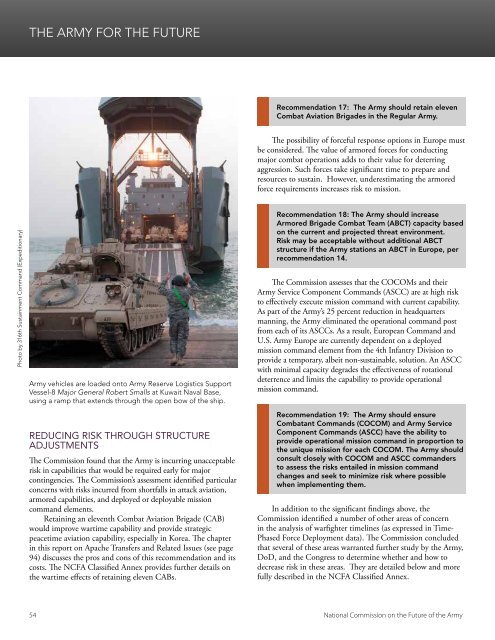THE FUTURE OF THE ARMY
Futurearmy
Futurearmy
Create successful ePaper yourself
Turn your PDF publications into a flip-book with our unique Google optimized e-Paper software.
<strong>THE</strong> <strong>ARMY</strong> FOR <strong>THE</strong> <strong>FUTURE</strong><br />
Recommendation 17: The Army should retain eleven<br />
Combat Aviation Brigades in the Regular Army.<br />
The possibility of forceful response options in Europe must<br />
be considered. The value of armored forces for conducting<br />
major combat operations adds to their value for deterring<br />
aggression. Such forces take significant time to prepare and<br />
resources to sustain. However, underestimating the armored<br />
force requirements increases risk to mission.<br />
Photo by 316th Sustainment Command (Expeditionary)<br />
Army vehicles are loaded onto Army Reserve Logistics Support<br />
Vessel-8 Major General Robert Smalls at Kuwait Naval Base,<br />
using a ramp that extends through the open bow of the ship.<br />
REDUCING RISK THROUGH STRUCTURE<br />
ADJUSTMENTS<br />
The Commission found that the Army is incurring unacceptable<br />
risk in capabilities that would be required early for major<br />
contingencies. The Commission’s assessment identified particular<br />
concerns with risks incurred from shortfalls in attack aviation,<br />
armored capabilities, and deployed or deployable mission<br />
command elements.<br />
Retaining an eleventh Combat Aviation Brigade (CAB)<br />
would improve wartime capability and provide strategic<br />
peacetime aviation capability, especially in Korea. The chapter<br />
in this report on Apache Transfers and Related Issues (see page<br />
94) discusses the pros and cons of this recommendation and its<br />
costs. The NCFA Classified Annex provides further details on<br />
the wartime effects of retaining eleven CABs.<br />
Recommendation 18: The Army should increase<br />
Armored Brigade Combat Team (ABCT) capacity based<br />
on the current and projected threat environment.<br />
Risk may be acceptable without additional ABCT<br />
structure if the Army stations an ABCT in Europe, per<br />
recommendation 14.<br />
The Commission assesses that the COCOMs and their<br />
Army Service Component Commands (ASCC) are at high risk<br />
to effectively execute mission command with current capability.<br />
As part of the Army’s 25 percent reduction in headquarters<br />
manning, the Army eliminated the operational command post<br />
from each of its ASCCs. As a result, European Command and<br />
U.S. Army Europe are currently dependent on a deployed<br />
mission command element from the 4th Infantry Division to<br />
provide a temporary, albeit non-sustainable, solution. An ASCC<br />
with minimal capacity degrades the effectiveness of rotational<br />
deterrence and limits the capability to provide operational<br />
mission command.<br />
Recommendation 19: The Army should ensure<br />
Combatant Commands (COCOM) and Army Service<br />
Component Commands (ASCC) have the ability to<br />
provide operational mission command in proportion to<br />
the unique mission for each COCOM. The Army should<br />
consult closely with COCOM and ASCC commanders<br />
to assess the risks entailed in mission command<br />
changes and seek to minimize risk where possible<br />
when implementing them.<br />
In addition to the significant findings above, the<br />
Commission identified a number of other areas of concern<br />
in the analysis of warfighter timelines (as expressed in Time-<br />
Phased Force Deployment data). The Commission concluded<br />
that several of these areas warranted further study by the Army,<br />
DoD, and the Congress to determine whether and how to<br />
decrease risk in these areas. They are detailed below and more<br />
fully described in the NCFA Classified Annex.<br />
54 National Commission on the Future of the Army


